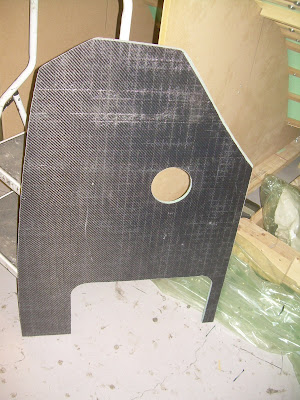I made holes for ventilation hatches in the anchor well.

And in the aft cabin front bulkhead. I also made the cut out for half the aft cabin entrance hatch.

And I started to back fill all the cut out edges.

This is the Bomar aft cabin entrance hatch, 47cm x 47 cm, this was the closest I got to the specified measures. I will have to mount it with the hinges at the side.

Then I tacked the cockpit floor in..

.. and taped a few joins.

I still have to make the aft bunk top. I started out tonight by cutting the foam roughly from the mould used for making the glueing flanges. I plan to pre fit the foam blank when I lower the port half again and then remove it in order to infuse it, mount the inspection hatch and put it back inside the aft cabin before hull joining. The bunk top is too big to fit the openings after hull join.

I also pre fitted some more foam in the bow area. I try to do as much as possible before joining the hull as after that it will be a lot of time consuming crawling in and out of the hull, as the companionway is quite awkward to enter with my relatively short legs when hull is on its side.

Next steps will probably be to lower the port half and fit the aft cabin front bulkhead, and some more taping. Then pre-fit the aft bunk top, remove peel ply from taping areas and make the necessary markings before lifting up again. After the bunk top is laminated and placed back in the hull it can be joined, hopefully during this week.
I also decided on using a
LINK SP II total hip replacement for the mast foot ball and cup. This is high quality CoCrMo ball and UHMW polyethylene cup. I could even consider using a highly x-linked polyethylene cup, but this is not as readily available without paying a fortune.

 Unidirectional carbon in the recessed area of the aft cabin bulkhead.
Unidirectional carbon in the recessed area of the aft cabin bulkhead. Now main cabin deck join and daggerboard to deck join taped
Now main cabin deck join and daggerboard to deck join taped




















































